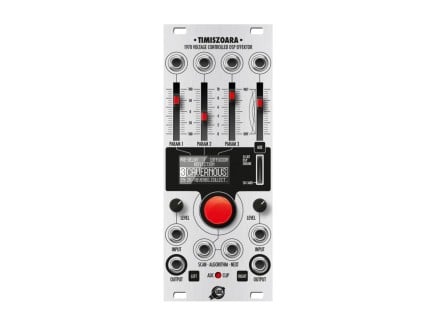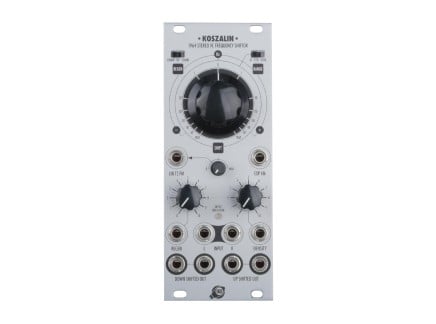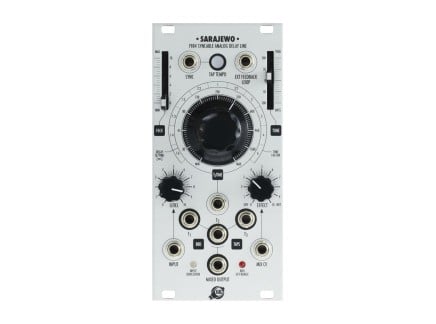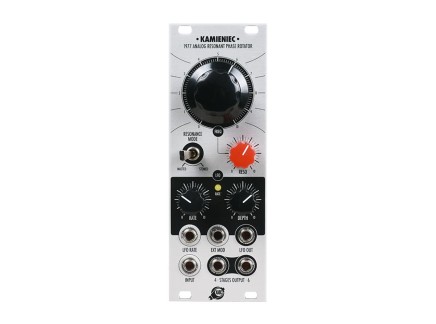If we were to make a list of changes that affected the landscape of modular synthesizers in the last several years, a significant increase in the availability of Eurorack multi-effects modules would certainly make it to the top. These days, we are lucky to have an abundance of options for modular sound processors, spanning from cut-and-dried single effect modules to multi-fx hubs and tremendously flexible effect environments. The options are abundant, and one can easily create a complete rack dedicated solely to sound processing, akin to a patchable, modulate-able pedalboard.
Today we are talking about a new extraordinary addition to this category—Timiszoara, from the widely-respected Polish Eurorack maker XAOC Devices. As with all of their other designs, Timiszoara is well thought out, powerful, and tremendously flexible. While in the video above, our patch pals Wes and Jacob share with you their favorite discoveries from Timiszoara, in this article we will take a closer look at what this module has to offer.
XAOC Timiszoara: a Sound Processing Powerhouse
In essence, Timiszoara is a stereo voltage-controlled DSP multi-algorithm sound processing module. It is based on the infamous Spin FV-1 integrated circuit—the same chip that is used in a range of acclaimed effect pedals and modules, including Erica Synths Black Hole DSP, and EarthQuaker Devices Rainbow Machine. The Spin FV-1 excels at stunning reverb, delay, and pitch-shifting effects, so rest assured, Timiszoara contains plenty of those, yet there is quite a bit more to it. Because of its sheer ubiquity, some designers shy away from the FV-1, which has "a sound" that many might immediately recognize. This has to do with the FV-1's use of a number of standard/stock algorithms…however, there's nothing that requires ambitious developers to use these algorithms alone.
XAOC put as much effort into designing effects for the module as they did into working on the hardware—and in fact, they developed a number of completely new algorithms for the FV-1 in order to push Timiszoara to the limits of the chip's possibilities. To be exact, there are 176 algorithms stored on the microSD card that comes with the module. The effects are organized categorically into multiple banks, and each bank holds 8 effects. Some banks offer collections of general-purpose effects, others offer more advanced and experimental means of processing sounds.
To name a few remarkable examples, the GLITCH bank presents a selection of effects emulating malfunctioning equipment, the RESONATOR bank, as one would expect, features a range of simple and complex resonator effects, the PARALLAX, and REVERB2 banks contain collections of stranger-than-usual reverbs and delays, while the DECONSTR and RECONSTR banks unleash a series of wild and unruly distortion and feedback effects.
Besides the effect banks that the module ships with, users are free to create new banks of favorites, as well as banks made up of other custom effects that were designed for the FV-1 chip. XAOC truly made Timiszoara an open and expandable framework for sound processing, and there are a couple of ways one may take advantage of that. One is to rely on the extensive library of effects developed by the community around Spin FV-1. Running a simple search for "FV-1 effects" online will surely present you with many options. For the sake of convenience, we can also point you toward this growing directory of FV-1 programs.
Users who are comfortable with programming can also opt for designing effects for the module themselves. This can be done using the SpinASM, as well as SpinCAD-designer software. The latter may be particularly of interest to those who are familiar with patching environments like Pure Data and Max, as it features a similar-looking graphical interface and workflow. It is worth mentioning, however, that both software programs can only run on a Windows operating system. Intel Mac users can also participate via Virtual Machine, Bootcamp, or something similar.
Hardware and Interface
Aesthetics and design have always been a big part of XAOC. This manifests not only through the playfully symbolic graphics and naming convention, but it is also evident from their consistently clear and intuitive panel layouts, as well as uncompromisingly high-quality internal components. Speaking of the latter, Timiszoara boasts audiophile-grade op-amps, and the FV-1 chip itself is equipped with 24-bit converters to ensure the best possible quality of effects.
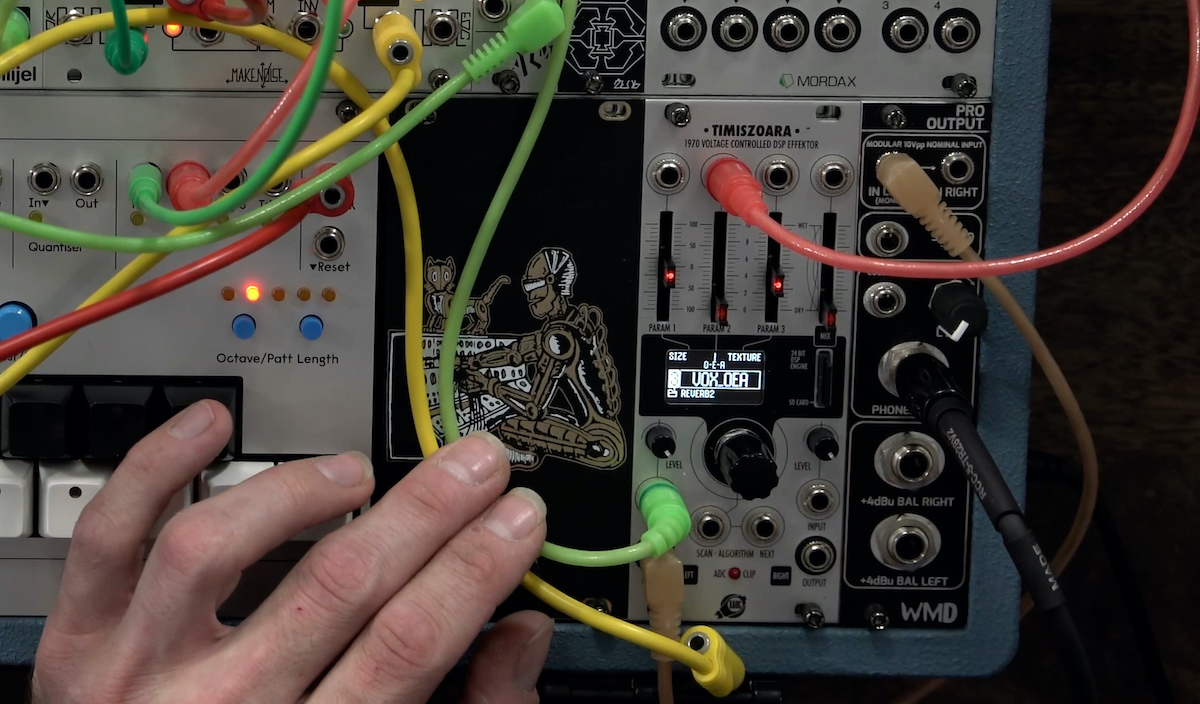
Interface-wise, the module is only 10HP wide, making it one of the most compact multi-fx modules in Eurorack, especially considering how powerful it is. The module's small size, however, does not come as a compromise on ergonomics. All of the connection jacks are conveniently positioned at the very top and bottom of the module, while the central part of the panel is dedicated to control and interaction.
Right in the middle of the panel is the high-definition OLED screen which provides means for navigation through the effect banks, and displays essential information regarding the current state of the module including names of the selected effect bank, preset, and controllable parameters. Browsing through the contents of the module is accomplished via the rotary encoder located right under the screen. If you press the encoder for one second, you enter the bank menu. Once you are in the bank, you can scroll through the available effects, then short-press on the desired preset to select it. There are also two inputs underneath the encoder labeled Scan, and a trigger Next. These allow you to browse through the presets within a bank using control voltage and trigger signals respectively.
Above the screen are four control sliders. The rightmost slider is used globally to adjust the dry/wet balance between the original signal, and its processed version. The remaining three parameter controls are algorithm-specific. Each slider features a dedicated control voltage input right above it. All CV inputs accept voltage in the range of 10Vpp. If you set the slider to the middle position, and send a bi-directional signal such as an LFO to the CV input, it will cover the full range of the parameter. Similarly, if the slider position is set all the way down, an envelope sent into the control voltage input will also sweep through the entire range of the parameter.
Audio signal inputs and outputs are positioned logically on the left and right sides of the panel, respectively. Each input also features a dedicated attenuator directly above it. Lastly, XAOC installed a clipping detector with a convenient LED indicator to help you make sure that the signal level is optimal at all times.
It is important to mention that FV-1 was initially designed for quiet instrument-level signals. To use it in the context of Eurorack, XAOC designed a special internal gain staging which significantly attenuates the signal at the input, and brings it back up to a desired level at the output. Therefore, to avoid unnecessary noise, it is highly recommended to avoid sending quiet signals into the module's inputs, and rather use the onboard level attenuators to trim down louder signals for the best sound quality.
Perfect For Any Occasion
Timiszoara has everything one might want in a modular multi-effect device. It is compact, it is powerful, it is intuitive in operation, it sounds fantastic, and it is expandable. The module will fit perfectly in a wide range of applications. Timiszoara can as easily be used as a simple set-and-forget effect as it can become the very source of composition itself with pinged resonators or dynamically changing effects. Really, what more can one ask for?
While we don't have an answer to this question, XAOC may. The company reportedly has a Timiszoara expander module planned to be released in the future. No exact announcements have yet been made regarding what enhancements it would provide, but we are confident that XAOC will not disappoint—they never do. Regardless of the brand's plans for the module's expansion, as it is now, Timiszoara feels as complete of a multi-effect module as one would hope…or even dream of it to be. Without a doubt, it is a great addition to any synthesizer or modular effect system.

